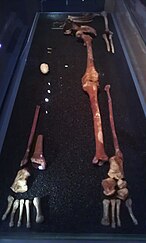Red Lady of Paviland
As Red Lady of Paviland (also: Red Lady ), an almost completely preserved, male skeleton is known that in a 1823 Goat's Hole -called limestone -Höhle at the cliff coast on the Gower Peninsula , 15 Miles West of Swansea in South Wales , discovered has been. It was the world's first fossil of an individual of the genus Homo and Hominini , which was described by a scientist in a publication. An age of more than 30,000 years is now ascribed to this find; He is thus one of the earliest settlers of anatomically modern humans ( Homo sapiens ) in Europe, known as Cro-Magnon humans , and is one of the oldest evidence of their presence in the British Isles .
The name of the skeleton refers to the site called Paviland and the coloring of the bones, which had been treated with red ocher before they were deposited in the cave . Its discoverer, William Buckland , carefully hid the bones and the pearls and ivory jewelry added to them, and concluded from the coloring and the funerary objects that they must be the remains of a woman. In his book Reliquiae Diluvianae , published as early as 1823 , Buckland - who took the Genesis story of the Bible literally - also explicitly pointed out that - despite numerous animal fossils - he had found no evidence of settlement in the cave before the Flood (p. 96); he therefore suspected that the supposed woman was a witch or a prostitute from the time of the Roman Empire .
For the bone find, the age of which is estimated to be around 21 years at the time of death, an age of 22,000 years was initially determined in 1968 with the help of radiocarbon dating , which would have meant that Wales would have been settled during one of the coldest phases of the Vistula Glaciation . In 1989, a new radiocarbon dating showed an age of 30,000 years, and a third dating in 2008 even showed an age of 33,000 years, that is, dating to the Denekamp warm period of the Vistula glaciation.
The Red Lady of Paviland's bones are kept in the Oxford University Museum of Natural History .
See also
Web links
- Great Sites: Paviland Cave. At: archaeologyuk.org , accessed May 29, 2016
- The oldest known buried remains in Britain. (with pictures) On: bradshawfoundation. com , accessed September 3, 2015
Individual evidence
- ↑ William Buckland : Reliquiae diluvianae; or, observations on the organic remains contained in caves, fissures, and diluvial gravel, and on other geological phenomena, attesting the action of an universal deluge. John Murray, London 1823, pp. 82-98 .
- ^ Ewen Callaway: Archeology: Date with history. In: Nature , Volume 485, 2012, pp. 27-29, doi: 10.1038 / 485027a
- ↑ Kenneth P. Oakley: The date of the "Red Lady" of Paviland. In: Antiquity. Volume 42, No. 168, 1968, pp. 306-307, doi : 10.1017 / S0003598X00118800 .
- ↑ Kevin Fleming et al .: Refining the eustatic sea-level curve since the Last Glacial Maximum using far- and intermediate-field sites. In: Earth and Planetary Science Letters. Volume 163, No. 1-4, 1998, pp. 327-342, doi: 10.1016 / S0012-821X (98) 00198-8
- ^ Robert EM Hedges et al .: Radiocarbon dates from the Oxford AMS system: Archaeometry datelist 9. In: Archaeometry. Volume 31, No. 1989, pp. 207-234, DOI: 10.1111 / j.1475-4754.1989.tb01015.x
- ^ Roger M. Jacobi and Tom Higham : The "Red Lady" ages gracefully: new ultrafiltration AMS determinations from Paviland. In: Journal of Human Evolution. Volume 55, No. 5, 2008, pp. 898-907, doi: 10.1016 / j.jhevol.2008.08.007



